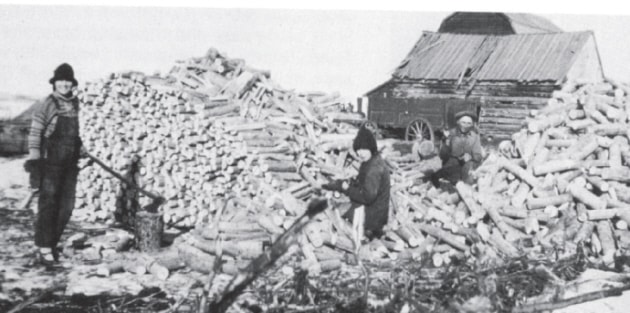Whether we like it or not we have all bravely faced the ongoing wrath of this winter since early November, but despite the snow, the wind, and the cold, we have survived because we are hardy and proudly stubborn Canadians. Over the years there have always been lots of tough winters, and this week in Reflections we will salute those large and determined pioneer families who for decades have faced Old man winter without all the ‘get warm quick’ amenities that are now only just a flick away in our day and age.
The winter of 1906-1907
From a copy of “The Ponoka Story”, which was written by our district and town old-timers, it was vividly recalled that after their first big hailstorm on August 19, 1905 had completely wiped out the crops, the next two winters would be as different as night and day. During the winter of 1905-06 the farmers were not able to take their sleighs out because there was very little snow, and all of the supplies were hauled by wagon.
In those early days blizzards were not the dangerous storms that swept the open prairies, because our country had lots of brush and trees, and the trusty teams of horses, if given their head could follow a trail and always arrive home safe. It was in the winter of 1906-07, just when many settlers were just getting established and especially trying to start into cattle, that they would experience the worst winter on record. Every old timer had a story of this wicked winter, and this account was written by a young homesteader’s wife Mrs. Charlie Shipley, who at the writing of the history book in 1971 had reached the age of 92 years.
She stressed that it was easy to remember that winter of 1906-07 because on November 2nd they received 10 inches of snow and it remained bitterly cold until December 10th when they got a few days of warmer weather but no melt. With everyone using their cutters or bobsleighs the roads were well packed, and with the farmers having only the usual amount of feed, the stock, especially the horses could graze on the wild grass all winter. Many of the homesteaders had a contract with a rancher to take in ten cows with calf for three years, while Charlie Shipley had taken in fifteen of his own.
December 1906 turned very cold again, with Christmas day hitting 30 degrees below zero. January stayed below zero for the entire month, with more snow piling up on the roads, which remained packed hard. Feed became very scare and high in price, and her husband had to haul a load of hay for 10 miles to hopefully last them until the spring. The Shipley’s had a deep little coulee by their log barn where they bedded their cattle down, and during that winter Charlie had to get up at least once a night to check on the herd, often having to build big fires close by to keep them warm. Most people managed to make it through, but many lost all their young calves and some of their cows. The snow was so deep at times that it covered the fences, and the roads were so packed that it was very hard to pass, and the snow was still around on May 1, 1907, when the Shipley’s had to take the cutter into Lamberton for supplies. A neighbour, Mr. Cairns wrote....’there were many fights that winter, with some rigs tipping over into the ditch when they tried to pass on the road. A horse could walk up to a coyote because it had to jump up so high, and many of those pesky critters were killed with clubs.”
Frank Brewster also fondly remembered his father’s story of that memorable winter. “In the summer of 1906 my father put up hay with Mr. Story, who lived on the farm later occupied by Mr. Harrington. Story would cut the hay and my father would rake and stack it for a half share, which he used to feed the 50 head of steers that he agreed to winter for Mr. Beebe of Beebe Town, Iowa. He batched on the homestead and hauled his hay every day to the cattle, and it was so cold that the only reason that he didn’t freeze to death was because he had a fur coat that was a couple of sizes to large for him, which he lived in all winter and slept in it too.”
Hugh Stevenson recalled that her husband told of hauling hay from the West head place west of Mirror, which took all day to make the round trip, and if the two outfits met on the trail, the lighter one would pull off, then the other would help to turn them right side up and then pull them back on the track with both teams. There has been many varying reports of the depth of the snow that winter, but most stories put it at six feet on the level. It didn’t drift, but just piled snow on snow for months, with absolutely no breaks for melting. The official record snowfall at Edmonton that winter was reported as 90.3 inches.
Here are a few more excerpts from a dairy about that horrific winter that appeared in the Ponoka Herald.
● October 14, 1906: The slough froze and we skated.
● November 3 and 4, 1906: snow fell for 31 hours and remained on the ground until May 24, 1907.
● The month of January 1907 averaged 27.1 degrees below zero, was warmest at noon and coldest at night.
● Hauled logs on Buffalo Lake on April 7, 1907.
So for the rest of the winter let’s turn up the furnace, dress warm, think spring, and try not to complain too much.
